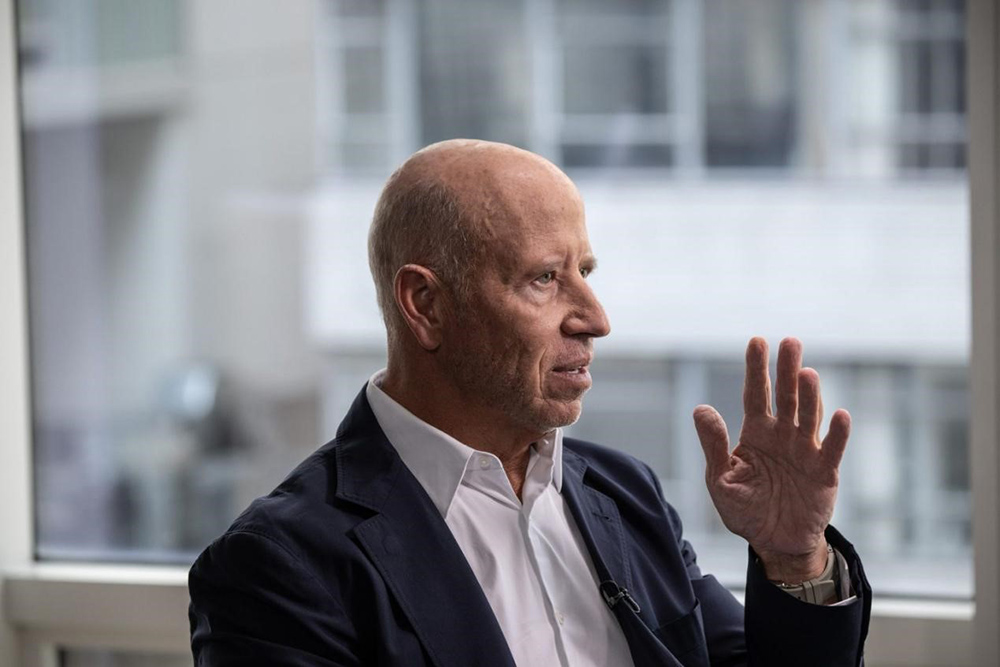
喜达屋资本集团首席执行官兼董事长巴里·斯特恩利希特(Barry Sternlicht)曾警告:“房地产市场将遭遇飓风。”现在,这位房地产投资公司背后的亿万富翁并没有改变他的观点。
据彭博社报道,在迈阿密海滩举行的iConnections’ Global Alts会议上,斯特恩利希特表示,“写字楼如今面临生存危机”。这绝不是什么新消息。数位首席执行官、经济学家和学者都对写字楼行业敲响了警钟,其中多数人强调,写字楼行业与其他商业地产困境的区别在于需求不足。
对于该行业来说,今年又是艰难的一年,而利率上升是罪魁祸首。在经历了低息借款时代之后,美联储突然加息给这一依赖债务的行业带来了冲击。但写字楼行业面临的不仅仅是高利率问题,而是在疫情爆发后,一种新的居家办公模式出现了。企业也在勉力应对利率高企带来的影响:通过减少实体办公空间来削减开支,甚至转向混合办公模式而非远程办公模式。
引用另一位房地产亿万富翁罗斯·佩罗(Ross Perot Jr.)接受《财富》杂志采访时的表述:“我们需要很多年才能真正了解疫情对世界造成的破坏。”他补充说,首先,“它打破了数百万人过去每天在实体办公室上班的习惯模式。”
据彭博社报道,斯特恩利希特表示,他预计办公空间的损失将超过1万亿美元,称其为“从未从疫情中恢复过来的资产类别”。据该媒体报道,斯特恩利希特估计整个资产类别的价值从原先的3万亿美元降至1.8万亿美元,他说,“有1.2万亿美元的损失分布在某个地方,没有人确切知道在哪里。”
目前尚不清楚他是否做了进一步阐述,但他确实抨击了美联储,称美联储的政策给“资本市场、房地产市场以及任何与收益率相关的领域造成了严重混乱”。这绝不是他第一次抨击美联储。在此前接受《财富》杂志采访时,他曾称美联储为“杰罗姆·鲍威尔(Jay Powell)和他的疯子团队”。在另一个场合,斯特恩利希特称美联储采取加息举措是“自寻死路”。显然,他并不喜欢鲍威尔,很可能是因为鲍威尔采取的加息举措给他的公司带来了潜在影响。
据彭博社报道,斯特恩利希特表示:“我们的职责是获得贷款。”而银行“不露面,他们甚至不按规则出牌。”
在去年初银行倒闭事件发生后,商业地产和银行之间的关系进一步恶化,尽管信贷本来就很紧张,但收紧贷款已成为一种常态。科恩-斯蒂尔斯金融公司(Cohen & Steers)房地产策略主管里奇·希尔(Rich Hill)当时对《财富》杂志表示:“当经济疲软时,就会出现这种情况,更不必提及银行体系出现摩擦的情况了。”
斯特恩利希特并不是唯一一个预测商业地产遭受灭顶之灾的人。
坎托·菲茨杰拉德(Cantor Fitzgerald)的亿万富翁董事长兼首席执行官霍华德·卢特尼克(Howard Lutnick)本月早些时候预测,未来两年商业房地产违约将达到7000亿至1万亿美元,除非利率迅速下降,但他认为这不太可能发生。卢特尼克表示:"我认为,未来18个月到两年,房地产市场将变得惨不忍睹。"
凯投宏观(Capital Economics)估计,去年商业房地产价值损失5,900亿美元,今年将再损失4,800亿美元,2025年将再损失1,200亿美元,从峰值到谷底的价值跌幅将达到24%。该研究公司预计,到2025年底,仅写字楼的价值就将从峰值到谷底猛跌40%以上,甚至到2040年也无法恢复。显然,未来还会面临更多困境,尤其是在债务到期的情况下,抑或是在再融资成本高昂或得来不易的情况下债务到期。
不过,穆迪分析公司(Moody's Analytics)的商业地产分析主管凯文·费根(Kevin Fagan)认为,“写字楼故事并不是一个大规模淘汰的故事,它更像是一个'需要时间才能实现正常化,并发现未来走向'的故事。”(财富中文网)
译者:中慧言-王芳
喜达屋资本集团(Starwood Capital Group)首席执行官巴里·斯特恩利希特(Barry Sternlicht),摄于去年接受采访时。
喜达屋资本集团首席执行官兼董事长巴里·斯特恩利希特(Barry Sternlicht)曾警告:“房地产市场将遭遇飓风。”现在,这位房地产投资公司背后的亿万富翁并没有改变他的观点。
据彭博社报道,在迈阿密海滩举行的iConnections’ Global Alts会议上,斯特恩利希特表示,“写字楼如今面临生存危机”。这绝不是什么新消息。数位首席执行官、经济学家和学者都对写字楼行业敲响了警钟,其中多数人强调,写字楼行业与其他商业地产困境的区别在于需求不足。
对于该行业来说,今年又是艰难的一年,而利率上升是罪魁祸首。在经历了低息借款时代之后,美联储突然加息给这一依赖债务的行业带来了冲击。但写字楼行业面临的不仅仅是高利率问题,而是在疫情爆发后,一种新的居家办公模式出现了。企业也在勉力应对利率高企带来的影响:通过减少实体办公空间来削减开支,甚至转向混合办公模式而非远程办公模式。
引用另一位房地产亿万富翁罗斯·佩罗(Ross Perot Jr.)接受《财富》杂志采访时的表述:“我们需要很多年才能真正了解疫情对世界造成的破坏。”他补充说,首先,“它打破了数百万人过去每天在实体办公室上班的习惯模式。”
据彭博社报道,斯特恩利希特表示,他预计办公空间的损失将超过1万亿美元,称其为“从未从疫情中恢复过来的资产类别”。据该媒体报道,斯特恩利希特估计整个资产类别的价值从原先的3万亿美元降至1.8万亿美元,他说,“有1.2万亿美元的损失分布在某个地方,没有人确切知道在哪里。”
目前尚不清楚他是否做了进一步阐述,但他确实抨击了美联储,称美联储的政策给“资本市场、房地产市场以及任何与收益率相关的领域造成了严重混乱”。这绝不是他第一次抨击美联储。在此前接受《财富》杂志采访时,他曾称美联储为“杰罗姆·鲍威尔(Jay Powell)和他的疯子团队”。在另一个场合,斯特恩利希特称美联储采取加息举措是“自寻死路”。显然,他并不喜欢鲍威尔,很可能是因为鲍威尔采取的加息举措给他的公司带来了潜在影响。
据彭博社报道,斯特恩利希特表示:“我们的职责是获得贷款。”而银行“不露面,他们甚至不按规则出牌。”
在去年初银行倒闭事件发生后,商业地产和银行之间的关系进一步恶化,尽管信贷本来就很紧张,但收紧贷款已成为一种常态。科恩-斯蒂尔斯金融公司(Cohen & Steers)房地产策略主管里奇·希尔(Rich Hill)当时对《财富》杂志表示:“当经济疲软时,就会出现这种情况,更不必提及银行体系出现摩擦的情况了。”
斯特恩利希特并不是唯一一个预测商业地产遭受灭顶之灾的人。
坎托·菲茨杰拉德(Cantor Fitzgerald)的亿万富翁董事长兼首席执行官霍华德·卢特尼克(Howard Lutnick)本月早些时候预测,未来两年商业房地产违约将达到7000亿至1万亿美元,除非利率迅速下降,但他认为这不太可能发生。卢特尼克表示:"我认为,未来18个月到两年,房地产市场将变得惨不忍睹。"
凯投宏观(Capital Economics)估计,去年商业房地产价值损失5,900亿美元,今年将再损失4,800亿美元,2025年将再损失1,200亿美元,从峰值到谷底的价值跌幅将达到24%。该研究公司预计,到2025年底,仅写字楼的价值就将从峰值到谷底猛跌40%以上,甚至到2040年也无法恢复。显然,未来还会面临更多困境,尤其是在债务到期的情况下,抑或是在再融资成本高昂或得来不易的情况下债务到期。
不过,穆迪分析公司(Moody's Analytics)的商业地产分析主管凯文·费根(Kevin Fagan)认为,“写字楼故事并不是一个大规模淘汰的故事,它更像是一个'需要时间才能实现正常化,并发现未来走向'的故事。”(财富中文网)
译者:中慧言-王芳
Starwood Capital Group’s chief executive and chairman previously warned of a “hurricane over real estate.” And the billionaire behind the real estate investment firm, Barry Sternlicht, hasn’t changed his tune.
At iConnections’ Global Alts conference in Miami Beach, according to Bloomberg, Sternlicht said, “the office market has an existential crisis right now.” This isn’t new information by any means. Several chief executives, economists, and academics have sounded the alarm for the office sector, with most stressing that the one thing that separates it from all other commercial real estate woes is demand.
It was a rough year for the sector, and higher interest rates were mostly to blame. After an era of cheap money, the Fed’s abrupt interest-rate-hiking regime created a bit of a shock for the debt-dependent industry. But the office sector faced more than high interest rates, since with the pandemic, a newfound ability to work from home emerged. Businesses, also grappling with the toll of higher rates, cut back by reducing physical office space, even with the shift toward hybrid work rather than remote work. To quote another real estate billionaire, “it’ll be years before we really understand the damage the pandemic did to the world,” Ross Perot Jr. previously told Fortune, adding that for one, “it broke the habit patterns of millions of people that used to go to work every day in a real office.”
Sternlicht said he sees more than $1 trillion of losses for the office space, calling it “one asset class that never recovered” from the pandemic, Bloomberg reported. According to the outlet, Sternlicht estimated the worth of the entire class at $.18 trillion, down from $3 trillion, saying, there’s “$1.2 trillion of losses spread somewhere, and nobody knows exactly where it all is.”
It’s not clear if he elaborated further, but he did rip the Federal Reserve, arguing that the central bank’s policies created a “serious mess in capital markets and real estate and anything that’s yield related.” It’s by no means his first time digging into the Fed, which he called “Jay Powell and his merry band of lunatics” in a prior interview with Fortune. On a separate occasion, Sternlicht called the Fed’s interest rate hikes “self-inflicted suicide.” Clearly, he’s not a fan, likely because of the potential effects Powell’s interest rate increases have had on his own company.
“We’re in the business of getting loans,” Sternlicht said, according to Bloomberg. And banks “don’t show up, they’re not even playing.”
The relationship between commercial real estate and banks worsened in the aftermath of the bank failures early last year—stricter lending became a norm, even though credit was already tight to begin with. “That’s what happens when you head into softer economic conditions, never mind one where there’s friction in the banking system,” Rich Hill, the head of real estate strategy at Cohen & Steers, told Fortune at the time.
Sternlicht is not the only one predicting a wipeout.
Cantor Fitzgerald’s billionaire chairman and chief executive, Howard Lutnick, earlier this month predicted between $700 billion to $1 trillion of commercial real estate defaults over the next two years—that is, unless interest rates fall quickly, which he said was unlikely. “I think it’s going to be a very, very ugly market in owning real estate over the next 18 months, two years,” Lutnick said.
For its part, Capital Economics estimated a $590 billion loss in commercial real estate property values last year, another $480 billion wipeout this year, and another $120 billion loss in 2025, for a 24% peak-to-trough value decline. For office alone, the research firm expects values to fall more than 40% peak-to-trough by the end of 2025, with no recovery even by 2040. Clearly, there will be more distress ahead, particularly driven by maturities, or debt coming due when refinancing isn’t cheap or easy.
Still, according to Moody’s Analytics’ head of commercial real estate analysis, Kevin Fagan, “the story of office isn’t a story of mass obsolescence, it’s more of a ‘it’s going to take time for it to normalize and discover what it is in the future.’”






